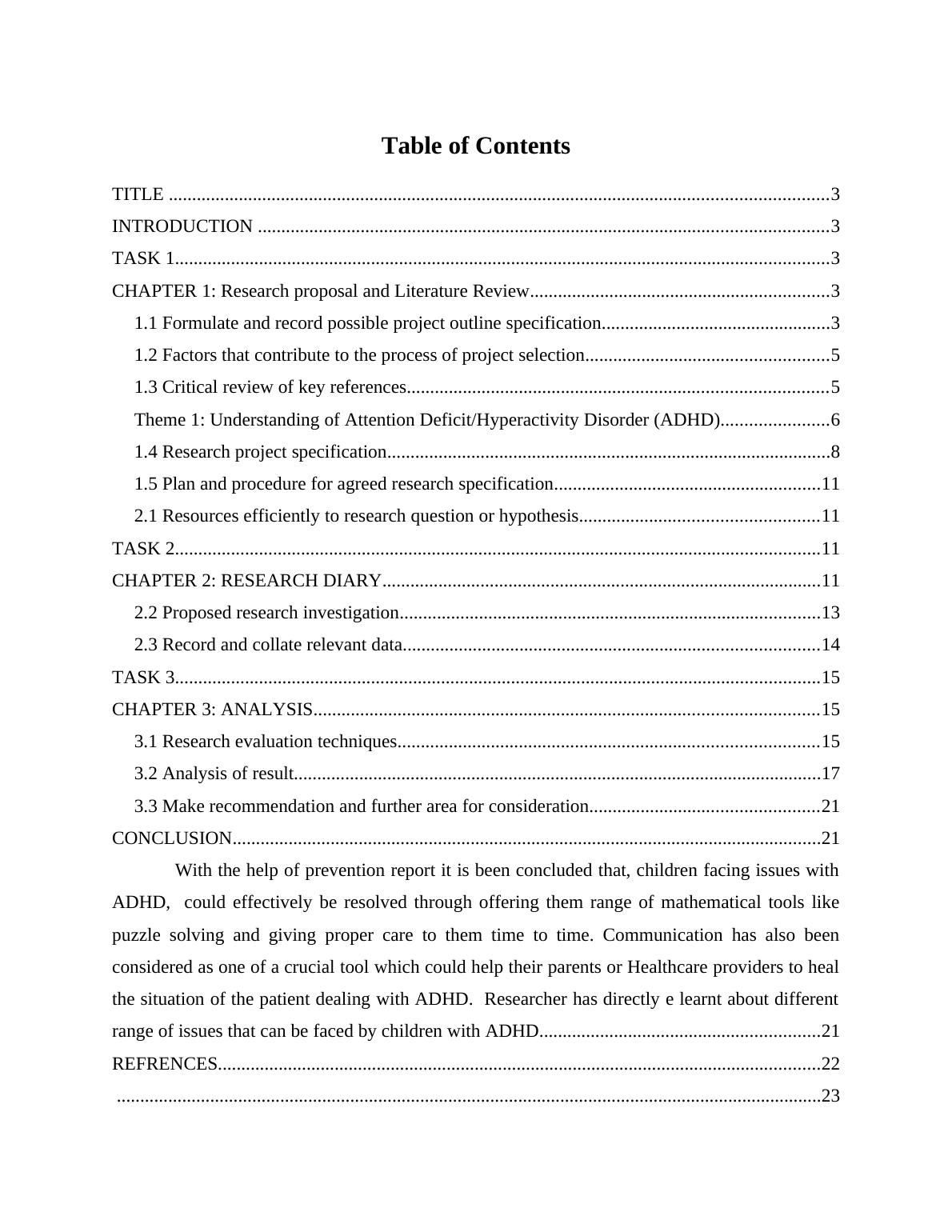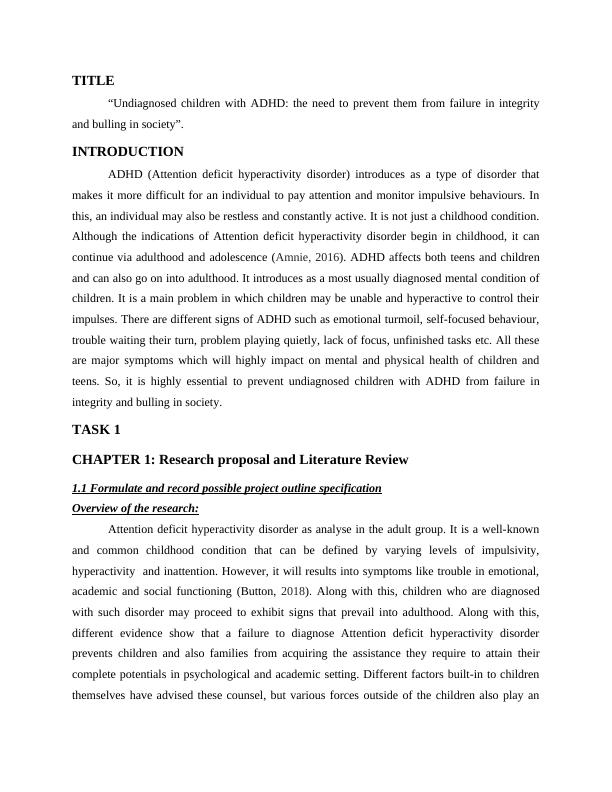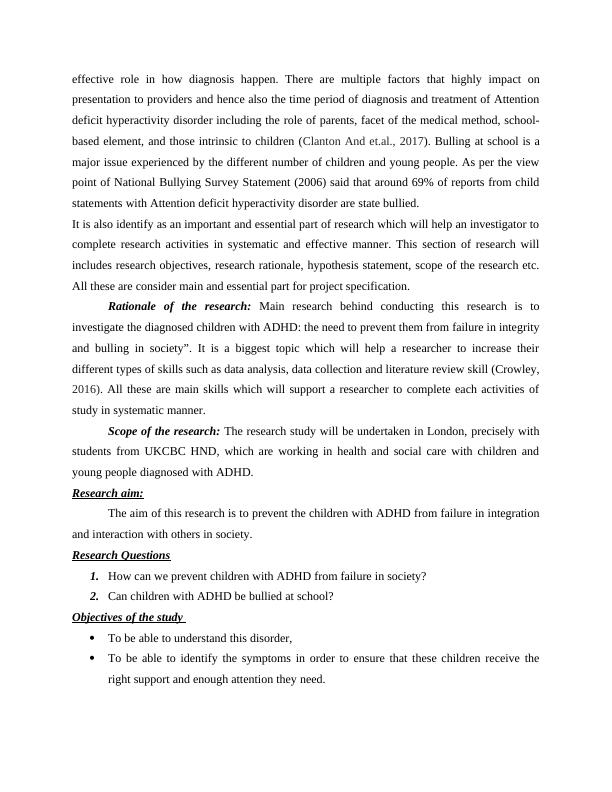Understanding of Attention Deficit/Hyperactivity Disorder
Added on 2020-10-05
27 Pages6737 Words191 Views
Research Project

Table of ContentsTITLE .............................................................................................................................................3INTRODUCTION ..........................................................................................................................3TASK 1............................................................................................................................................3CHAPTER 1: Research proposal and Literature Review................................................................31.1 Formulate and record possible project outline specification.................................................31.2 Factors that contribute to the process of project selection....................................................51.3 Critical review of key references..........................................................................................5Theme 1: Understanding of Attention Deficit/Hyperactivity Disorder (ADHD).......................61.4 Research project specification...............................................................................................81.5 Plan and procedure for agreed research specification.........................................................112.1 Resources efficiently to research question or hypothesis...................................................11TASK 2..........................................................................................................................................11CHAPTER 2: RESEARCH DIARY..............................................................................................112.2 Proposed research investigation..........................................................................................132.3 Record and collate relevant data.........................................................................................14TASK 3..........................................................................................................................................15CHAPTER 3: ANALYSIS............................................................................................................153.1 Research evaluation techniques..........................................................................................153.2 Analysis of result.................................................................................................................173.3 Make recommendation and further area for consideration.................................................21CONCLUSION..............................................................................................................................21With the help of prevention report it is been concluded that, children facing issues withADHD, could effectively be resolved through offering them range of mathematical tools likepuzzle solving and giving proper care to them time to time. Communication has also beenconsidered as one of a crucial tool which could help their parents or Healthcare providers to healthe situation of the patient dealing with ADHD. Researcher has directly e learnt about differentrange of issues that can be faced by children with ADHD............................................................21REFRENCES.................................................................................................................................22.......................................................................................................................................................23

TITLE “Undiagnosed children with ADHD: the need to prevent them from failure in integrityand bulling in society”.INTRODUCTION ADHD (Attention deficit hyperactivity disorder) introduces as a type of disorder thatmakes it more difficult for an individual to pay attention and monitor impulsive behaviours. Inthis, an individual may also be restless and constantly active. It is not just a childhood condition.Although the indications of Attention deficit hyperactivity disorder begin in childhood, it cancontinue via adulthood and adolescence (Amnie, 2016). ADHD affects both teens and childrenand can also go on into adulthood. It introduces as a most usually diagnosed mental condition ofchildren. It is a main problem in which children may be unable and hyperactive to control theirimpulses. There are different signs of ADHD such as emotional turmoil, self-focused behaviour,trouble waiting their turn, problem playing quietly, lack of focus, unfinished tasks etc. All theseare major symptoms which will highly impact on mental and physical health of children andteens. So, it is highly essential to prevent undiagnosed children with ADHD from failure inintegrity and bulling in society. TASK 1CHAPTER 1: Research proposal and Literature Review1.1 Formulate and record possible project outline specificationOverview of the research:Attention deficit hyperactivity disorder as analyse in the adult group. It is a well-knownand common childhood condition that can be defined by varying levels of impulsivity,hyperactivity and inattention. However, it will results into symptoms like trouble in emotional,academic and social functioning (Button, 2018). Along with this, children who are diagnosedwith such disorder may proceed to exhibit signs that prevail into adulthood. Along with this,different evidence show that a failure to diagnose Attention deficit hyperactivity disorderprevents children and also families from acquiring the assistance they require to attain theircomplete potentials in psychological and academic setting. Different factors built-in to childrenthemselves have advised these counsel, but various forces outside of the children also play an

effective role in how diagnosis happen. There are multiple factors that highly impact onpresentation to providers and hence also the time period of diagnosis and treatment of Attentiondeficit hyperactivity disorder including the role of parents, facet of the medical method, school-based element, and those intrinsic to children (Clanton And et.al., 2017). Bulling at school is amajor issue experienced by the different number of children and young people. As per the viewpoint of National Bullying Survey Statement (2006) said that around 69% of reports from childstatements with Attention deficit hyperactivity disorder are state bullied. It is also identify as an important and essential part of research which will help an investigator tocomplete research activities in systematic and effective manner. This section of research willincludes research objectives, research rationale, hypothesis statement, scope of the research etc.All these are consider main and essential part for project specification. Rationale of the research: Main research behind conducting this research is toinvestigate the diagnosed children with ADHD: the need to prevent them from failure in integrityand bulling in society”. It is a biggest topic which will help a researcher to increase theirdifferent types of skills such as data analysis, data collection and literature review skill (Crowley,2016). All these are main skills which will support a researcher to complete each activities ofstudy in systematic manner. Scope of the research: The research study will be undertaken in London, precisely withstudents from UKCBC HND, which are working in health and social care with children andyoung people diagnosed with ADHD.Research aim:The aim of this research is to prevent the children with ADHD from failure in integrationand interaction with others in society. Research Questions1.How can we prevent children with ADHD from failure in society?2.Can children with ADHD be bullied at school?Objectives of the study To be able to understand this disorder,To be able to identify the symptoms in order to ensure that these children receive theright support and enough attention they need.

1.2 Factors that contribute to the process of project selectionThere are different factors which contributes to the project selection process. Someimportant factors are determined as under: Introduction: It is a first process of selecting project in which different aspects will beincluded. These factors mainly related with, selection of interesting topic, development of aimsand objectives, creation of research questions etc (Ewald and Haldeman, 2016). All these areconsidered as main aspects which will help a researcher to complete research in more effectiveand systematic manner. Literature review: It introduces as a second step for selecting project. In this sectionresearcher must use different books, journals, articles and many other relevant sources whichwill help them to collect in-depth information about the topic. Methodology: It is another important phase for selecting project. In this section, differentmethods must be included such as research philosophy, research design, data collection, dataanalysis, qualitative and quantitative research etc. All these are major parts for collectingaccurate and reliable information about the topic. Data collection and interpretation: This is most important step for selecting andcompleting project. In this section, questionnaire instrument will be used by researcher to gatherreliable and valid information regarding the current study (Flannigan and et.al., 2018). Conclusion and recommendation: This is consider as a last phase of research in whichentire detail about the project will be included. In this section, some recommendation will beprovided to researcher about how to overcome issues founded in questionnaire. 1.3 Critical review of key referencesLiterature review refers as a kind of scholarly paper which covers actual understandingincluding, substantive findings, methodological as well as theoretical contribution to specificresearch topic. In addition, it is an explicit, systematic as well as reproducible approach foranalysing, evaluating, synthesizing and identifying existing structure of completed work oractivity produced by practitioners, investigators and scholars (Gates, 2019). In this section, allresearch objectives and questions will be addressed by researcher in more systematic andeffective manner. One of the main purpose of literature review is to find out inconsistencies,conflict and gaps in previous study.

Theme 1: Understanding of Attention Deficit/Hyperactivity Disorder (ADHD)Attention-Deficit/Hyperactivity disorder can be described as most common mentaldisorders affecting children which consist inattention, hyperactivity and impulsivity. A personhaving problem of ADHD has certain differences in development and activity of brain thatimpacts on attention, ability to sit still as well as self control (Gluckman and FRS, 2018).Initially, it has been analysed that children who are not attentive then they have trouble infocussing their attention, concentrating and staying on task as they are not able to listen will todirections. As per views given by Shirin Hasan (2019), they may not finish what they have startor miss the same and may remain in daydream or dawdle too much along with having conditionof absent minded of forgetful and lose track track of their things. Secondly, kids who arehyperactive can be observed as restless, easily bored & fidgety and such individuals may facetrouble to sit still or staying quite while required. These children may rush through things &responsible for making careless errors and they observed as climb, jump or rough house whenthat is not needed along with acting in ways or disrupt others. Thirdly, children having an issueof impulsive then they can quick take action without thinking anything and they often interrupt,might push or grab and find it hard to wait (Honkasilta and Vehkakoski, 2019). Such kids mayobserve to do things without taking permission, pick things of other people without asking themand act in risky manners. Moreover, these individuals have few of emotional reaction that seemstoo intense for specific condition. At the other hand, the physicians make decision about that a kid is suffering from ADHDwhile they have observed several symptoms which are discussed here. Firstly, it involves theobservation of hyperactivity, impulsivity or distractibility of a child that go beyond normalsituation according to their actual age. Secondly, it consist about behaviours of them that havebeen going on since the child was young. Thirdly, the child at home and school get affected byseveral factors including impulsivity, distractibility and hyperactivity. However, the problemsrelated to health and leaning are observed after carrying out appropriate check up that areresponsible for causing problems for an individual. At the other hand, it has been analysed that undiagnosed ADHD in children which isresponsible for failure of treatment due to severe complications (Johnson, 2018). It is necessaryto promote awareness regarding this mental health problem among society which encouragepeople to analyse early symptoms of ADHD and prefer to consult with psychiatrist for further

End of preview
Want to access all the pages? Upload your documents or become a member.
Related Documents
Undiagnosed children with ADHD: the need to prevent them from failure in integrity and bullying in societylg...
|26
|6250
|89
Attention Deficit Hyperactive Disorder Reportlg...
|16
|4352
|16
Public Health Assignment (Doc)lg...
|13
|3381
|99
Proposal for a Policy Change: Addressing ADHD at Joint Air Base Pearl Harborlg...
|11
|4366
|369
Health Behaviour | List of High Impact Articleslg...
|3
|422
|19
Factors That Contribute In The Process Of Research Project Selection : Assignmentlg...
|18
|4043
|460
